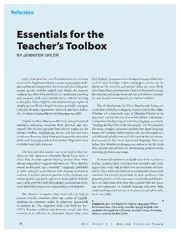
ERIC EJ997536: Essentials for the Teacher's Toolbox PDF
Preview ERIC EJ997536: Essentials for the Teacher's Toolbox
Essentials for the Teacher’s Toolbox BY JENNIFER UHLER Every profession has a set of essential tools for carrying later. Indeed, classrooms have changed: language films have out its work. Airplane mechanics cannot repair engines with- evolved into YouTube videos, newspaper articles can be out sophisticated diagnostics, wrenches, and pliers. Surgeons found on the Internet, and picture slides are more likely cannot operate without scalpels and clamps. In contrast, to be PowerPoint presentations. However, Ramirez’s criteria teaching has often been perceived as a profession requiring for selecting and using visual aids are still relevant remind- only students, chalk, and a blackboard in order for learning ers and should remain part of any teacher’s toolbox. to take place. There might be some truth to this perception of simplicity, but effective English teachers generally rely upon The third selection, by Albert Marckwardt, focuses on a number of tools—approaches, activities, and basic materi- a tool that is familiar to language learner and teacher alike. als—to make teaching efficient and learning enjoyable. Whether it’s a dog-eared copy of Merriam-Webster or an electronic version the size of a mobile phone, a dictionary English teachers often assemble their own professional is important for figuring out and using language accurately. toolboxes, collecting essentials, both physical and con- “Getting the Most Out of the Dictionary” (1974) recognizes ceptual. The articles reprinted here discuss staples for the the many complex questions teachers face about language teacher’s toolbox. Highlighting no-cost and low-cost ways forms and varieties, and it outlines why the dictionary is a to enhance learning, these three articles provide reminders valuable and reliable source of information. In the twenty- of the tools language teachers have at their disposal in their first century we have more data at our fingertips than ever everyday work with students. before, but, whether dictionaries are online or on the shelf, they remain critical tools for determining pronunciation, The first tool that teachers can work with is their en- meaning, grammar, and usage. thusiasm and demeanor. Elizabeth Hamp-Lyons takes a closer look at what separates boring teachers from those Professional toolboxes no doubt vary from teacher to who develop positive rapport with students. “Your Most Es- teacher; teachers have tried-and-true activities and tech- sential Audiovisual Aid—Yourself!” (originally published niques that work well in their own instructional environ- in 1981) reminds us of obvious tools that are available to ments. These three selections serve as reminders of universal teachers. A teacher’s physical position in the classroom, eye essentials for teachers to include in their toolboxes. Our contact, posture, personal expression, vocal quality, and talk physical presence in the classroom, visual aids, and diction- time can be powerful tools that enhance presentation of ma- aries are important tools that, when paired with our train- terial and build constructive relationships with learners. ing and experience as English language educators, help make teaching and learning more pleasant and, ultimately, Mac Ramirez recognizes that visual aids can help to more successful. recreate real-life situations when the reality of English- speaking environments might be otherwise inaccessible JENNIFER UHLER is the Regional English Language Officer to students. In “The Neglected Tools Can Work for You” for Central Asia. Previously, Jennifer taught English and (1975), Ramirez outlines easy-to-create visual aids that worked with teachers in Estonia, Austria, Turkey, Romania, continue to be effective in classrooms almost forty years Mexico, and the United States. 32 2012 NUMBER 4 | E N G L I S H T E A C H I N G F O R U M
